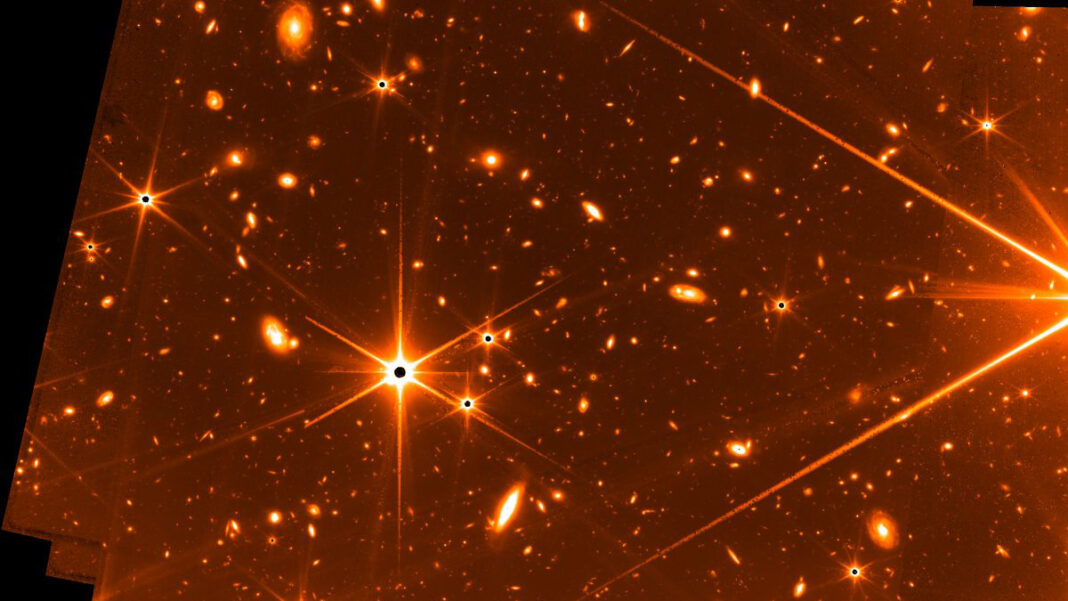NASA will unveil the first science-quality images from its next-generation James Webb Space Telescope on Tuesday (July 12). You can watch the event live here on Space. com courtesy of the agency beginning at 10:30 a.
m. EDT (1430 GMT). As highly anticipated as these images will be, they aren’t the first photos from the massive space observatory.
The James Webb Space Telescope, also known as JWST or Webb, launched on Dec. 25, 2021, and since then, NASA and its partners on the project have offered tantalizing peeks at what is to come. The image above, which NASA released on Wednesday (July 6), represents 32 hours of observing time from JWST’s Fine Guidance Sensor.
That device is not one of the telescope’s four key science instruments; instead, it keeps the observatory pointing steadily at its target. Still, the image is the deepest field ever captured — a superlative that NASA Administrator Bill Nelson hinted one of the formal first images would steal. We’ll be updating this gallery live on Tuesday to share the official first images as they are unveiled.
This image wasn’t quite taken by JWST — it shows the spacecraft sailing away from the Ariane 5 rocket that blasted it off Earth on Dec. 25, 2021. The view, with Earth in the background, was streamed home from a camera that rode on the launcher.
JWST’s very first image was not much to look at. Released in February, this image shows an ordinary star dubbed HD 84406 , which mission engineers used to tune the observatory. In these early images, the star appears once for each of the 18 golden hexagons that encompass the observatory’s massive mirror .
Just weeks after launch, the mirror segments were all askew, as the bright spots, each labeled with the segment it represents, show. The two circled trios labeled “wing” mark the side panels of the mirror that were stowed for launch and unfolded as the observatory trekked out to its station. One of JWST’s very first images was a ” selfie ” released in February, early in the observatory’s commissioning process.
Mission personnel used a special camera built into the NIRCam instrument to capture a view of starlight reflecting off one of the primary mirror segments. At the time, the mirror’s segments weren’t properly aligned, which is why only one segment is illuminated; engineers captured the “selfie” to inform the alignment process that turned the 18 segments into one perfectly-tuned mirror. The first step of aligning JWST’s mirror segments tamed the mess of the observatory’s first view into an orderly reflection of the mirror itself.
By later in February, the 18-fold appearance of the star matched the hexagonal pattern of the mirror itself. Next, mission personnel adjusted the segments to pull the 18 images together, stacking them into one clear image in which a single star shone. In March, JWST was no longer seeing the universe in 18-fold harmony, allowing it to capture this stunning image of a star .
But at this point, only one of the observatory’s instruments was itself aligned properly to the mirror — the near-infrared camera, or NIRCam, which captured this view. It’s this image that started to hint at what scientists and space fans could look forward to from the new observatory, since the smudges that surround the star each represent a distant galaxy . Later JWST images sparkle not only in comparison with earlier images, but also with images captured by older observatories.
By May, NASA released a vivid comparison of a view from the Mid-Infrared Instrument, or MIRI, juxtaposed with a view of the same patch of the sky as seen by the Spitzer Space Telescope . Spitzer, which NASA retired in 2020, was also equipped to study infrared light, but its smaller mirror and older instruments show when contrasted with MIRI. While it’s JWST’s images that space fans might be most excited to see, scientists are also eager for images like this, an image taken during late-stage testing of the observatory’s NIRSpec instrument.
NIRSpec is a spectrograph, which means it splits up light from any given source by wavelength. The result is a chemical barcode that scientists can use to identify what celestial objects are made of. NIRSpec is particularly powerful because it can gather spectra from many different sources at once: Each horizontal line in the test image represents a separate object.
On Friday (July 8), NASA released a list of five celestial objects that will star, so to speak, in the images the agency and its partners will release on Tuesday. Pictured here is the Carina Nebula , a bright cloud of gas and dust located about 7,600 light-years away from Earth. NASA has also promised a spectrum of an exoplanet dubbed WASP-96 b, a giant, hot world that seems to have nary a single cloud in its atmosphere.
Also on the docket are the Southern Ring Nebula, the galaxy group Stephan’s Quintet and an image relying on the huge mass of a nearby galaxy to bend and magnify light from a more distant target. .
From: space
URL: https://www.space.com/james-webb-space-telescope-first-photos/



